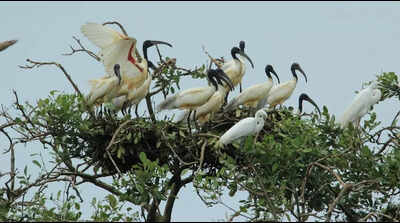ARTICLE AD BOX

Census data reveals there are 1,30,796 nesting birds in 27,646 nests
Kendrapada: Population of nesting birds has marginally increased by 673 in Bhitarkanika National Park during this monsoon, according to a census report released by forest officials on Monday.Data revealed there are 1,30,796 nesting birds in 27,646 nests on 1,409 trees this time. The count in 2024 found 1,30,123 nesting birds in 27,272 nests on 1,300 trees.The numbers were obtained through the direct sighting method. “We monitored all the water bodies and mangrove forests in Bhitarkanika from Aug 30 to Sept 1 and conducted the bird surveys and census,” said Varadaraj Gaonkar, divisional forest officer (DFO) of the park.Around 21 individuals, including noted ornithologists, officials of wildlife organisations and wildlife activists, formed three teams that participated in the bird count at four mixed heronry sites — Mathaadia, Laxmiprasaddia, Durgaprasaddia and Balidia forests — within Bhitarkanika, where a large number of birds laid eggs.The Asian open-billed stork dominated the nesting colonies with 15,919 nests. Other significant species included the black-headed ibis, purple heron, large egret, intermediate egret, little egret, grey heron, little cormorant, black-crowned night heron and darter.
Among the heronry sites, Laxmiprasaddia (13,594 nests) and Mathaadia (13,261 nests) emerged as the major nesting hubs. “The preferred nesting trees are bani, guan, kerauan, oruan, sinduka and sundari,” said Gaonkar.Forest department records revealed that 97,866 nesting birds were counted in 2020, which increased to 1,08,639 in 2021, 1,16,070 in 2022, and 1,23,867 in 2023 during monsoon.Consistent presence of diverse water bird species underscores the ecological importance of Bhitarkanika mangroves as one of the largest heronry in Asia.
“The annual nesting congregation not only enhances the ecological richness of the mangrove ecosystem but also provides critical insights into the conservation status of colonial water birds. The forest department remains committed to protecting wetland habitats and safeguarding the future of these avian populations,” added the DFO.Monsoon showers have revitalised Bhitarkanika as myriad birds flocked to the mangrove trees for nesting.
“Local birds arrive in Bhitarkanika to lay eggs during monsoon, while migratory species come in winter,” Gaonkar stated.The gathering of birds, who frequently visit open wetlands abundant in fish, prawns, frogs, snakes and molluscs, offers a visual treat. Availability of ample fish in the water bodies and the park’s distance from human habitation provide extensive feeding grounds for the birds.



.png)
.png)
.png)
















 4 days ago
5
4 days ago
5








 English (US) ·
English (US) ·